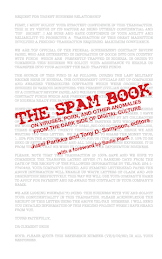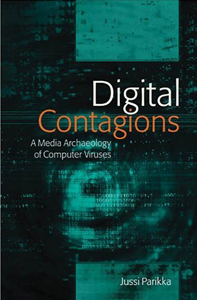
Writing about spam and editing this book was fun. It was bizarre to understand the lack of research into this defining feature of digital culture, and only now PhDs and research into spam cultures are emerging. For me, spam is a perfect index, or more accurately a vehicle that we can use to drive into such themes as security, delineation of order and disorder in software cultures, capitalism and the non-signifying production of value, desires of consumerism and the weird automated processes running wild on the underbelly of networks.
From the back cover of the Spam Book:
For those of us increasingly reliant on email networks in our everyday social interactions, spam can be a pain; it can annoy; it can deceive; it can overload. Yet spam can also entertain and perplex us. This book is an aberration into the dark side of network culture. Instead of regurgitating stories of technological progress or over celebrating creative social media on the Internet, it filters contemporary culture through its anomalies. The book features theorists writing on spam, porn, censorship, and viruses. The evil side of media theory is exposed to theoretical interventions and innovative case studies that touch base with new media and Internet studies and the sociology of new network culture, as well as post-presentational cultural theory.
And some blurps...
“Parikka and Sampson present the latest insights from the humanities into software studies. This compendium is for all you digital Freudians. Electronic deviances no longer originate in Californian cyber fringes but are hardwired into planetary normalcy. Bugs breed inside our mobile devices. The virtual mainstream turns out to be rotten. The Spam book is for anyone interested in new media theory.” —Geert Lovink, Dutch/Australian media theorist
“What if all those things we most hate about the Internet—the spam, the viruses, the phishing sites, the flame wars, the latency and lag and interruptions of service, and the glitches that crash our computers—what if all these are not bugs, but features? What if they constitute, in fact, the way the system functions? The Spam Book explores this disquieting possibility.”
—Steven Shaviro, DeRoy Professor of English, Wayne State University
Contents:
Foreword, Sadie Plant.
On Anomalous Objects of Digital Culture: An Introduction, Jussi Parikka and Tony D. Sampson.
CONTAGIONS
Mutant and Viral: Artificial Evolution and Software Ecology, John Johnston.
How Networks Become Viral: Three
Questions Concerning Universal Contagion, Tony D. Sampson.
Extensive Abstraction in Digital Architecture, Luciana Parisi.
Unpredictable Legacies: Viral Games in the Networked World, Roberta Buiani.
BAD OBJECTS.
Archives of Software—Malicious Codes and the Aesthesis of Media Accidents, Jussi Parikka.
Contagious Noise: From Digital Glitches to Audio Viruses, Steve Goodman.
Toward an Evil Media Studies, Matthew Fuller and Andrew Goffey.
PORNOGRAPHY.
Irregular Fantasies, Anomalous Uses: Pornography Spam as Boundary Work, Susanna Paasonen.
Make Porn, Not War: How to Wear the Network’s Underpants, Katrien
Jacobs.
Can Desire Go On Without a Body?: Pornographic Exchange as Orbital Anomaly, Dougal Phillips.
CENSORED.
Robots.txt: The Politics of Search Engine Exclusion, Greg Elmer.
The Internet Treats Censorship as a Malfunction and Routes Around It?: A New Media
Approach to the Study of State Internet Censorship, Richard Rogers.
CODA
On Narcolepsy, Alexander R. Galloway and Eugene Thacker.








No comments:
Post a Comment